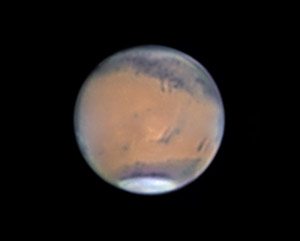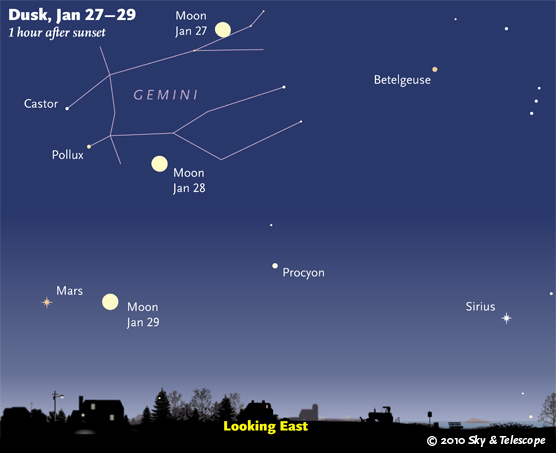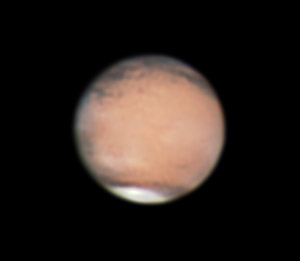Some daily events in the changing sky for January 22 – 30.

Mars's north polar cap was still dazzlingly prominent, and dark Mare Cimmerium was prominent in the north, when Bill Flanagan of the Houston Astronomical Society took this image on January 22nd. Note the bright patch of clouds in the Elysium area just below center. The central-meridian longitude was 210°. South is up, and celestial east is to the right. Click for more views.
Flanagan used a 14-inch Schmidt-Cassegrain telescope and a Luminera LU-075M video camera. Stacked-video imagery like this, done by a skilled user, can show much more detail on a planet than the eye can see through the same telescope.
Bill Flanagan
Friday, January 22
Midway between Mars and Sirius, and a little higher, is lesser Procyon. The three form a pattern like the wide roof of a low-peaked house.
Saturday, January 23
Sunday, January 24
Monday, January 25
The Dipper is standing on its handle; the Cassiopeia W is balanced on one end. About midway between them (and a bit higher) is Polaris, the North Star.
Tuesday, January 26
Wednesday, January 27

Watch the big bright Moon cross Gemini on its way to Mars late this week.
Sky & Telescope diagram
Thursday, January 28
Friday, January 29
Saturday, January 30
Want to become a better amateur astronomer? Learn your way around the constellations. They're the key to locating everything fainter and deeper to hunt with binoculars or a telescope. For an easy-to-use constellation guide covering the whole evening sky, use the big monthly map in the center of each issue of Sky & Telescope, the essential magazine of astronomy. Or download our free Getting Started in Astronomy booklet (which only has bimonthly maps).

The Pocket Sky Atlas plots 30,796 stars to magnitude 7.6 — which may sound like a lot, but that's less than one star in an entire telescopic field of view, on average. By comparison, Sky Atlas 2000.0 plots 81,312 stars to magnitude 8.5, typically one or two stars per telescopic field. Both atlases include many hundreds of deep-sky targets — galaxies, star clusters, and nebulae — to hunt among the stars.
Sky & Telescope
Once you get a telescope, to put it to good use you'll need a detailed, large-scale sky atlas (set of charts; the standards are Sky Atlas 2000.0 or the smaller Pocket Sky Atlas) and good deep-sky guidebooks (such as Sky Atlas 2000.0 Companion by Strong and Sinnott, the more detailed and descriptive Night Sky Observer's Guide by Kepple and Sanner, or the classic Burnham's Celestial Handbook). Read how to use them effectively.
Can a computerized telescope take their place? I don't think so — not for beginners, anyway (and especially not on mounts that are less than top-quality mechanically). As Terence Dickinson and Alan Dyer say in their Backyard Astronomer's Guide, "A full appreciation of the universe cannot come without developing the skills to find things in the sky and understanding how the sky works. This knowledge comes only by spending time under the stars with star maps in hand and a curious mind." Without these, "the sky never becomes a friendly place."
More beginners' tips: "How to Start Right in Astronomy".
This Week's Planet Roundup
Mercury is having a good morning apparition. Look for it low in the southeast about an hour before your local sunrise time. Don't confuse it with Antares roughly 30° to its upper right, or Altair a similar distance to Mercury's left or upper left.
Venus is hidden behind the glare of the Sun.

Mars was showing much of its "bland side" when S&T's Sean Walker took this image on the evening of January 26th (at 3:42 January 27th Universal Time). The dark-collared north polar cap was still very prominent. Dark, narrow Mare Sirenum is at top right, and the Solis Lacus complex is at top left. South is up.
"Lots of clouds this year on Mars, as well as here in New Hampshire!" writes Walker. He used a 14-inch Schmidt-Cassegrain telescope and a DMK21AU04.AS video camera. Stacked-video imagery like this can show detail on a planet much more clearly than the eye can see through the same telescope.
S&T: Sean Walker
Mars, fiery bright at magnitude –1.3, shines low in the east-northeast in twilight and higher in the east later in the evening. It's in Cancer, nearly midway between Regulus below it and Pollux and Castor above it. Mars is highest in the south around midnight.
In a telescope Mars is 14 arcseconds wide, as large as it will become this year. The big, white north polar cap is in fine view, bordered by a very wide dark zone. Identify other surface features using the Mars map and observing guide in the December Sky & Telescope, page 57. Mars is closest to Earth on January 27th, when it will be 14.1 arcseconds wide. It comes to opposition on the 29th.
Jupiter (magnitude –2.0) shines in the west-southwest in twilight and sets soon after dark.
Saturn (magnitude +0.8, in Virgo) rises in the east around 10 p.m. and stands highest in the south around 4 a.m. In earliest dawn, trace the huge, horizontal line of Spica, Saturn, Regulus, Mars, and Pollux all the way from high in the south to lower in the west-northwest. In a telescope Saturn's rings are tilted 4.8° from edge-on to us, almost the maximum tilt we'll see until next August.
Uranus (magnitude 5.9, just south of the Circlet of Pisces) is getting low in the southwest after dusk.
Neptune is lost in the sunset.
Pluto is very low in the east-southeast before dawn.
All descriptions that relate to your horizon or zenith — including the words up, down, right, and left — are written for the world's mid-northern latitudes. Descriptions that also depend on longitude (mainly Moon positions) are for North America. Eastern Standard Time (EST) equals Universal Time (also known as UT, UTC, World Time, or GMT) minus 5 hours.
To be sure to get the current Sky at a Glance, bookmark this URL:
http://SkyandTelescope.com/observing/ataglance?1=1
If pictures fail to load, refresh the page. If they still fail to load, change the 1 at the end of the URL to any other character and try again.
 0
0
Comments
You must be logged in to post a comment.